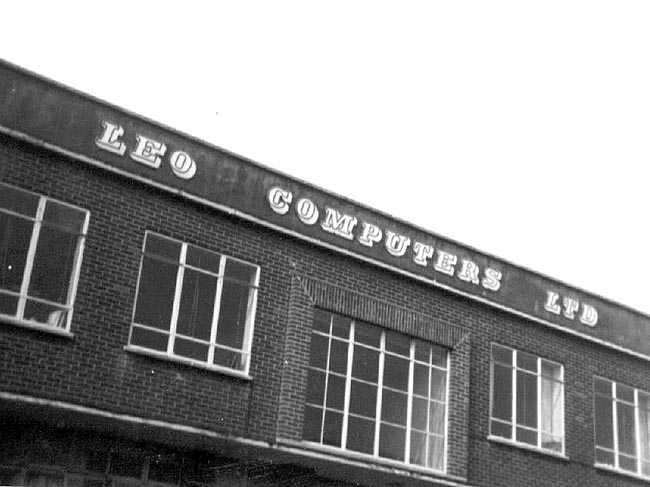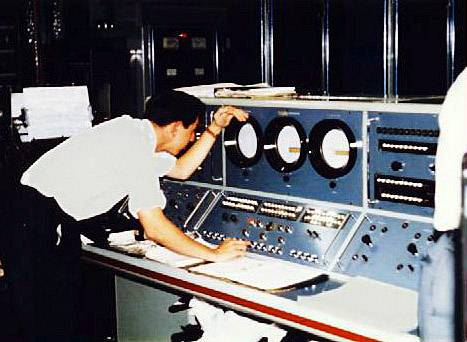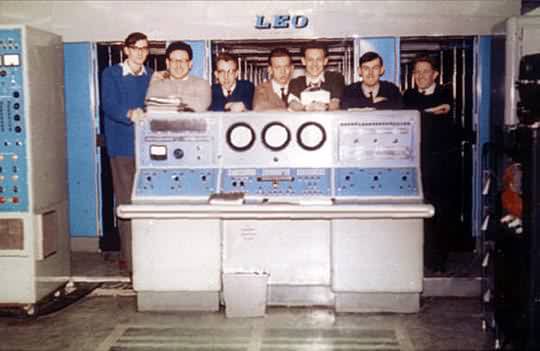

Five years after the work to build LEO commenced, it became clear to all involved that improvements could be made to the design. As in most cases like this, ideas came to light that were too late to be added to LEO but which could be held for the time in which the back up computer would be built. John Simmons felt that if this were the case, then why not build two new machines, using the improvements in both instead of having one as a backup. This would leave LEO obsolete, to be retired, but would leave Lyons with two much more improved machines. But why stop with two machines when the technology was so marvelled by the rest of the country? Why not use this to the advantage of Lyons and sell similar machines?
Simmons presented this idea to the Lyons board, with the reaction seeming to be very encouraging. Simmons then suggested to the company that in order to market the computers well, they should distance this new subsidiary company under a different name. The board agreed, and Leo Computers Ltd. was set up on 4th November 1954. They eventually moved into their own home at Minerva Road in North Acton, soon beginning work on the new model for Lyons, which was dubbed LEO II.

Unfortunately, despite the awe and wonder which greeted the unveiling of LEO I, the British government were less than willing to warm up to the idea of computers as anything other than scientific tools, and even then their interest was limited. Such was the case that government help was incredibly difficult to gain unfortunately, Leo Computers did not receive any.
Even without this help, the company believed that it could convince businesses of the benefits of computing in the workplace. In 1954, construction began on the LEO II. The machine would not differ all that much from the design of LEO I, but would instead improve on what was established. Shorter delay lines meant that pulses cycling around the store now took 125 microseconds as opposed to the 500 microseconds LEO I took. Another improvement implemented by Pinkerton was that the number of totals which could be held in the arithmetic unit was increased from three to sixteen. LEO II would still use paper and punched card inputs and outputs, each of which would be the fastest available. The result was that when LEO II was completed, the machine would be four times faster than its predecessor.
Unfortunately, the resources available to Leo Computers meant that the construction of LEO II, which should have been completed by the end of 1955, was actually finished in May 1957, two years overdue. One of the reasons for this was that the design team working on LEO II were the same pioneers who had designed and run LEO I. The staff working for Leo Computers was increased from the men who had built the original computer, however, these were also the same people who were responsible for maintaining and running operations on LEO I. On top of designing and constructing LEO II and running the day to day work on LEO I for Lyons and its many other customers, Leo computers’ staff also had to work on designing devices which could be used with LEO II for the customers who would be buying the machines. Devices such as faster printers which could print both numbers and text, and document readers which would read markings on paper in order to replace punched card devices. The strain on the staff was immense, and David Caminer had had enough. He demanded that staff in Leo computer stop working on designs for new peripherals for the company until the LEO construction had been completed. This was agreed with the board, however, a trip to America by Anthony Barnes and Raymond Thompson showed that work in the US has had progressed rapidly, with some impressive breakthroughs being made. Amongst these was the introduction of Magnetic Core Stores. These were smaller, faster, and more importantly, a lot faster than the mercury delay lines which had been used on LEO I, and the first LEO II.
It was clear that if Leo computers were to market their machines for customers, that the Magnetic core storage was a far more appealing option. Therefore it was insisted by Thompson that although all engineers should spend their time developing LEO II as Caminer had demanded, at least some of their time should be devoted to designing a magnetic core which could be used for their own machines.
Whilst in America for his research trip, Thompson found that a huge amount of money had been put into computer research. Most of this was a side effect of the Cold War, however, the effect this had on the industry was immense. Advancements made had suddenly turned companies such as IBM into large scale producers who were making a number of different models at once, and had over 100 customers waiting on orders. Ironically, US experts considered LEO old fashioned and out dated. Their opinion was that they were behind the times in terms of research and development, especially considering that some companies were spending more on computers than the entire budget of Leo Computers.
Thompson came back to the UK to write a report which explained that although America considered LEO outdated, there was no one who had come close to the standards the company had achieved in terms of programming and use of their computer. Newspapers of the time got wind of the report and pointed out the fact that American companies were charging upwards of £100,000 for a computer which was of a lower quality than a computer which could be bought in the UK for only £75,000 in comparison.
The development of LEO II was slow in moving forwards, partly due to the fact that the staff of Leo Computers was not big enough to develop the new machine, program, and develop new peripherals at the same time. One of the tasks which the team had to perform was creating new programs for LEO I, which was still performing tasks for Lyons. As it proved itself capable of more and more tasks, more were assigned to the computer. As difficult as the job was, the team continued to do their best to continue, even when met with a loss from the team. Derek Hemy, who had done a lot of the programming work on LEO I had been offered a job working for EMI. He was the first member of the LEO team to leave the company, but he would not be the last. The problem with his leaving was that he was one of the more skilled members of the team. His experience while not irreplaceable would be sorely missed.
Despite the slow work, the first LEO II to be completed was delivered and installed in Cadby Hall in July 1957. Immediately the machine was inundated with work, both for Lyons, and like LEO I before it, work for other customers in the form of a bureau service. One of the customers who used this service was Ford, who used LEO II for payroll, much in the way Lyons had first used LEO I, and envisioned themselves doing for the long term future.

Leo computers suffered a number of setbacks in regards to selling their computers to other businesses. A number of computer manufacturers had now appeared int he UK, some British, and some from America. Beyond this, and probably the biggest setback that the company had was the stigma of its parent company. Despite success in both fields, nobody wanted to invest money in a computer to run their business when it was made by a company who specialised in making cakes.
The downside to this was that people who saw Leo Computers in this light normally wouldn’t see the obvious; Leo were still ahead in terms of what they had accomplished and the programs they wrote for their computers. Other companies were catching up, and had resources for more research, or the production of other models, but for the time being, Leo were still the ahead of the field in what they could offer businesses. Soon, they had the opportunity to show this to the world with their first two orders.
W.D & H.O. Wills of Imperial Tobacco, and Stewarts & Lloyds the steelmakers both ordered a LEO II. These orders followed a specific routine in the way they were carried out, which was the same for each order Leo received.
A member of the senior systems staff would visit the client company for three months, analysing their entire operation. This would be to see how the current operations worked, and to gage what exactly the customer needed for their machine, much in the way systems analysts have been doing since. During this time a number of staff from the customer company would visit Cadby Hall in order to sit a LEO aptitude test. Should they pass this, they were sent on a five week course learning everything there was to know about the computers. These staff would then assist the Leo employees and start to write the initial programs that their LEO II would run. These courses would often run right up until delivery of the computer, with staff being trained on how to program for the computer, and how to maintain and repair the machine itself. All of this training would be included in the price of the computer. This generally meant that the value of the package the customer received was far greater in value than what was paid for the computer. The downside to the process apart from the fact that the company were not charging enough for the service they were giving, the specialists sent to each company to analyse the operations were normally kept on as supervisors for the new computer, diminishing the already small group of staff working for Leo Computers.
The first LEO computer to be installed for an outside customer was LEO II/3, the machine ordered by Stewarts & Lloyds in May 1958 where it performed tasks ranging from simple payroll programs, mastered many years before by Lyons, to complex mathematical equations. LEO II/3 ran for Stewarts and Lloyds until 1971.
The reason LEO II/2 was not delivered first to W.D & H.O. Wills was due to the fact that they had ordered some extra peripherals for their LEO. One of these was a simple addition of a magnetic drum memory store, which whilst requiring extra work to be added, could be included relatively easily. The other addition which was ordered was a high speed printer that could print alphanumeric characters. Unfortunately, such a printer was not readily available, and so Leo had to order one from a company called Powers-Samas. It became clear after a year of waiting, that Power-Samas were unable to deliver the order, as the machine they advertised was unreliable. The amount of cancelled orders which came of the printer eventually forced Powers-Samas to be taken over by BTM to form International Computers and Tabulators.
In the meantime, the men at Lyons struggled to get a machine working for the computer; however this delayed the computer by two years.
Eventually, eleven LEO II’s were built. The first obviously going to Lyons, as the backup/replacement for LEO I. The fifth machine stayed with Leo Computers for their own office. The others were all sold to other businesses, with only one problem, in the form of the British Oxygen’s LEO. Even this was not so much a problem of the computer, rather a problem with the design specification laid out when visiting the company.